Strategic IS/IT Implementation for Organizational Innovation
VerifiedAdded on 2023/05/29
|13
|3198
|215
Report
AI Summary
This report delves into the strategic application of Information Systems (IS/IT) within organizations to foster innovation. It begins by showcasing examples of IS/IT-driven innovation, such as Transaction Processing Systems (TPS), Management Information Systems (MIS), Decision Support Systems (DSS), and Neural Networks and Expert Systems, highlighting their roles in data management and decision-making. The report then identifies critical success factors for IT innovations, emphasizing the importance of top management commitment, the composition and teamwork of IT teams. It further examines the impact of internal factors, including organizational structure, managerial IT knowledge, and financial resources, as well as external factors, such as technological advancements, social influences, and organizational politics, on the success of IS/IT implementations. The report concludes with recommendations and guidelines for organizations, focusing on IT asset security, investment in new technologies, and smarter IT procurement, to support and enhance their innovation efforts. This analysis aims to provide a comprehensive understanding of the strategic use of IS/IT and its impact on organizational success.
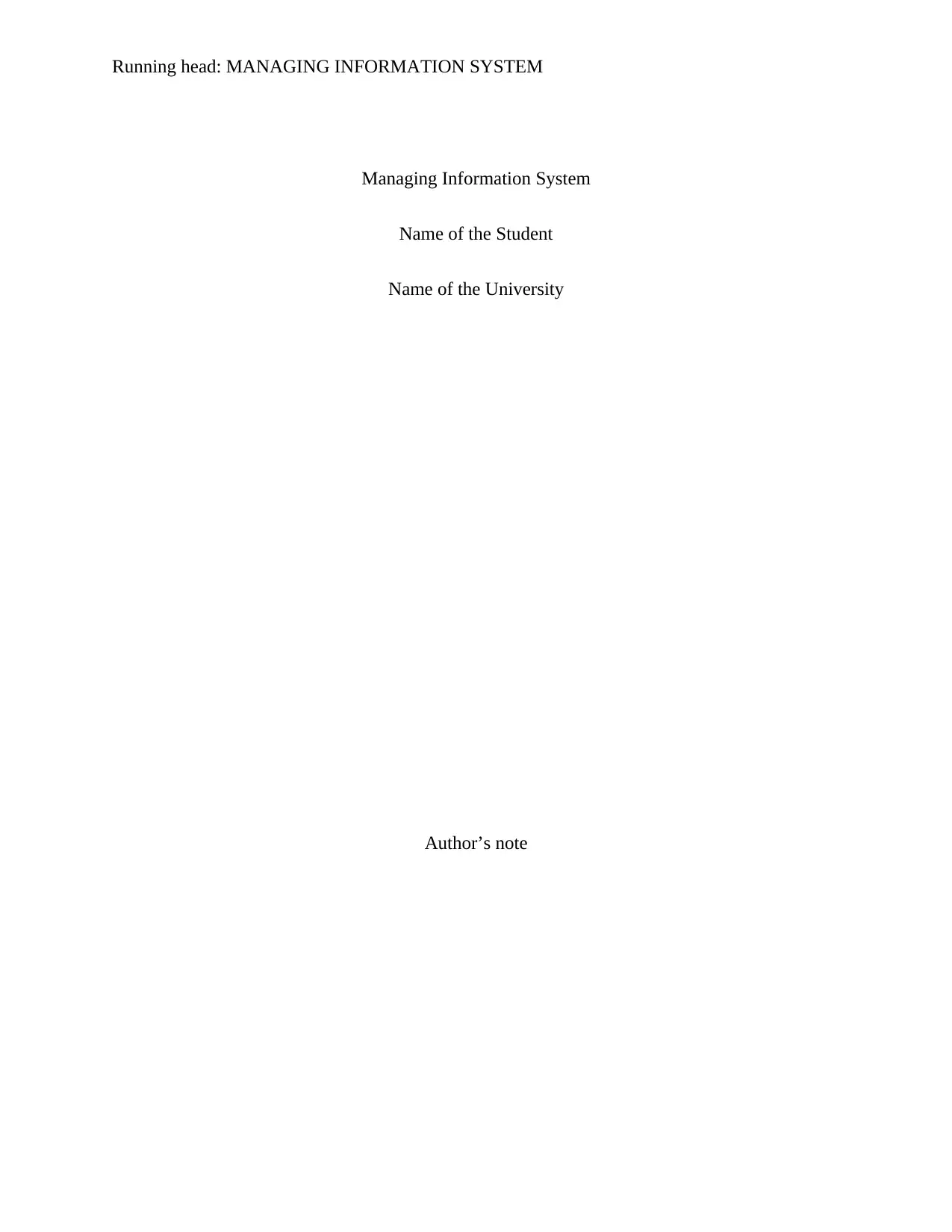
Running head: MANAGING INFORMATION SYSTEM
Managing Information System
Name of the Student
Name of the University
Author’s note
Managing Information System
Name of the Student
Name of the University
Author’s note
Paraphrase This Document
Need a fresh take? Get an instant paraphrase of this document with our AI Paraphraser
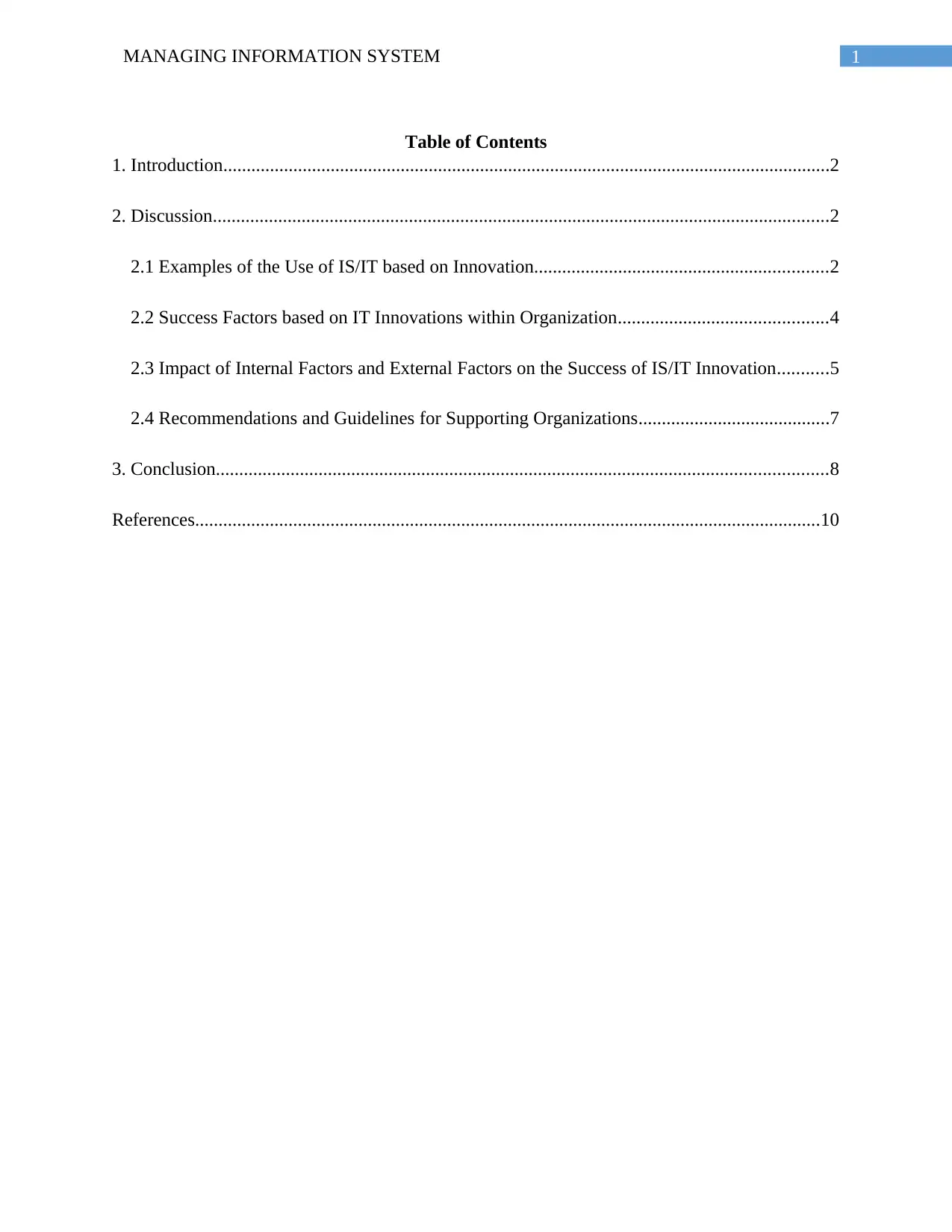
1MANAGING INFORMATION SYSTEM
Table of Contents
1. Introduction..................................................................................................................................2
2. Discussion....................................................................................................................................2
2.1 Examples of the Use of IS/IT based on Innovation...............................................................2
2.2 Success Factors based on IT Innovations within Organization.............................................4
2.3 Impact of Internal Factors and External Factors on the Success of IS/IT Innovation...........5
2.4 Recommendations and Guidelines for Supporting Organizations.........................................7
3. Conclusion...................................................................................................................................8
References......................................................................................................................................10
Table of Contents
1. Introduction..................................................................................................................................2
2. Discussion....................................................................................................................................2
2.1 Examples of the Use of IS/IT based on Innovation...............................................................2
2.2 Success Factors based on IT Innovations within Organization.............................................4
2.3 Impact of Internal Factors and External Factors on the Success of IS/IT Innovation...........5
2.4 Recommendations and Guidelines for Supporting Organizations.........................................7
3. Conclusion...................................................................................................................................8
References......................................................................................................................................10
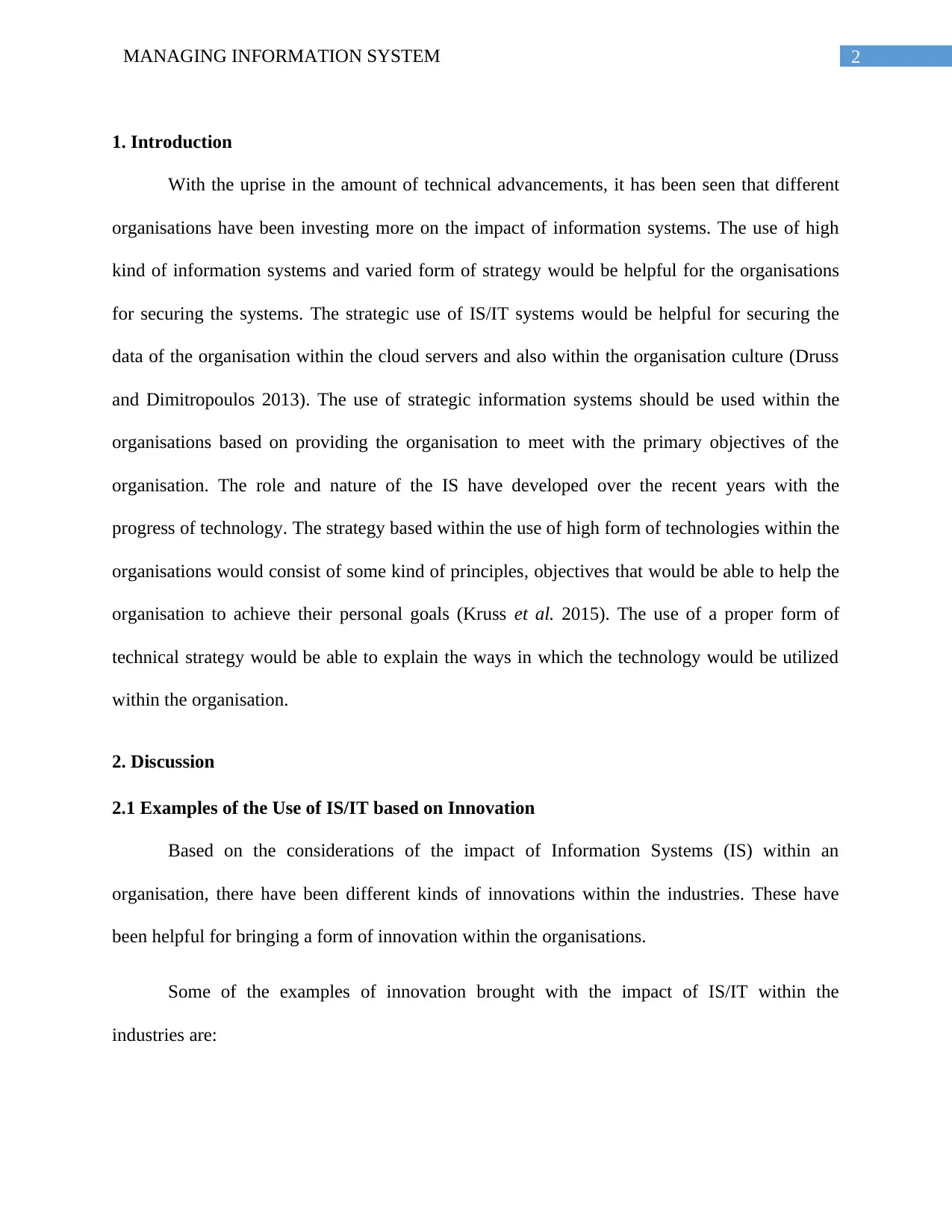
2MANAGING INFORMATION SYSTEM
1. Introduction
With the uprise in the amount of technical advancements, it has been seen that different
organisations have been investing more on the impact of information systems. The use of high
kind of information systems and varied form of strategy would be helpful for the organisations
for securing the systems. The strategic use of IS/IT systems would be helpful for securing the
data of the organisation within the cloud servers and also within the organisation culture (Druss
and Dimitropoulos 2013). The use of strategic information systems should be used within the
organisations based on providing the organisation to meet with the primary objectives of the
organisation. The role and nature of the IS have developed over the recent years with the
progress of technology. The strategy based within the use of high form of technologies within the
organisations would consist of some kind of principles, objectives that would be able to help the
organisation to achieve their personal goals (Kruss et al. 2015). The use of a proper form of
technical strategy would be able to explain the ways in which the technology would be utilized
within the organisation.
2. Discussion
2.1 Examples of the Use of IS/IT based on Innovation
Based on the considerations of the impact of Information Systems (IS) within an
organisation, there have been different kinds of innovations within the industries. These have
been helpful for bringing a form of innovation within the organisations.
Some of the examples of innovation brought with the impact of IS/IT within the
industries are:
1. Introduction
With the uprise in the amount of technical advancements, it has been seen that different
organisations have been investing more on the impact of information systems. The use of high
kind of information systems and varied form of strategy would be helpful for the organisations
for securing the systems. The strategic use of IS/IT systems would be helpful for securing the
data of the organisation within the cloud servers and also within the organisation culture (Druss
and Dimitropoulos 2013). The use of strategic information systems should be used within the
organisations based on providing the organisation to meet with the primary objectives of the
organisation. The role and nature of the IS have developed over the recent years with the
progress of technology. The strategy based within the use of high form of technologies within the
organisations would consist of some kind of principles, objectives that would be able to help the
organisation to achieve their personal goals (Kruss et al. 2015). The use of a proper form of
technical strategy would be able to explain the ways in which the technology would be utilized
within the organisation.
2. Discussion
2.1 Examples of the Use of IS/IT based on Innovation
Based on the considerations of the impact of Information Systems (IS) within an
organisation, there have been different kinds of innovations within the industries. These have
been helpful for bringing a form of innovation within the organisations.
Some of the examples of innovation brought with the impact of IS/IT within the
industries are:
⊘ This is a preview!⊘
Do you want full access?
Subscribe today to unlock all pages.

Trusted by 1+ million students worldwide
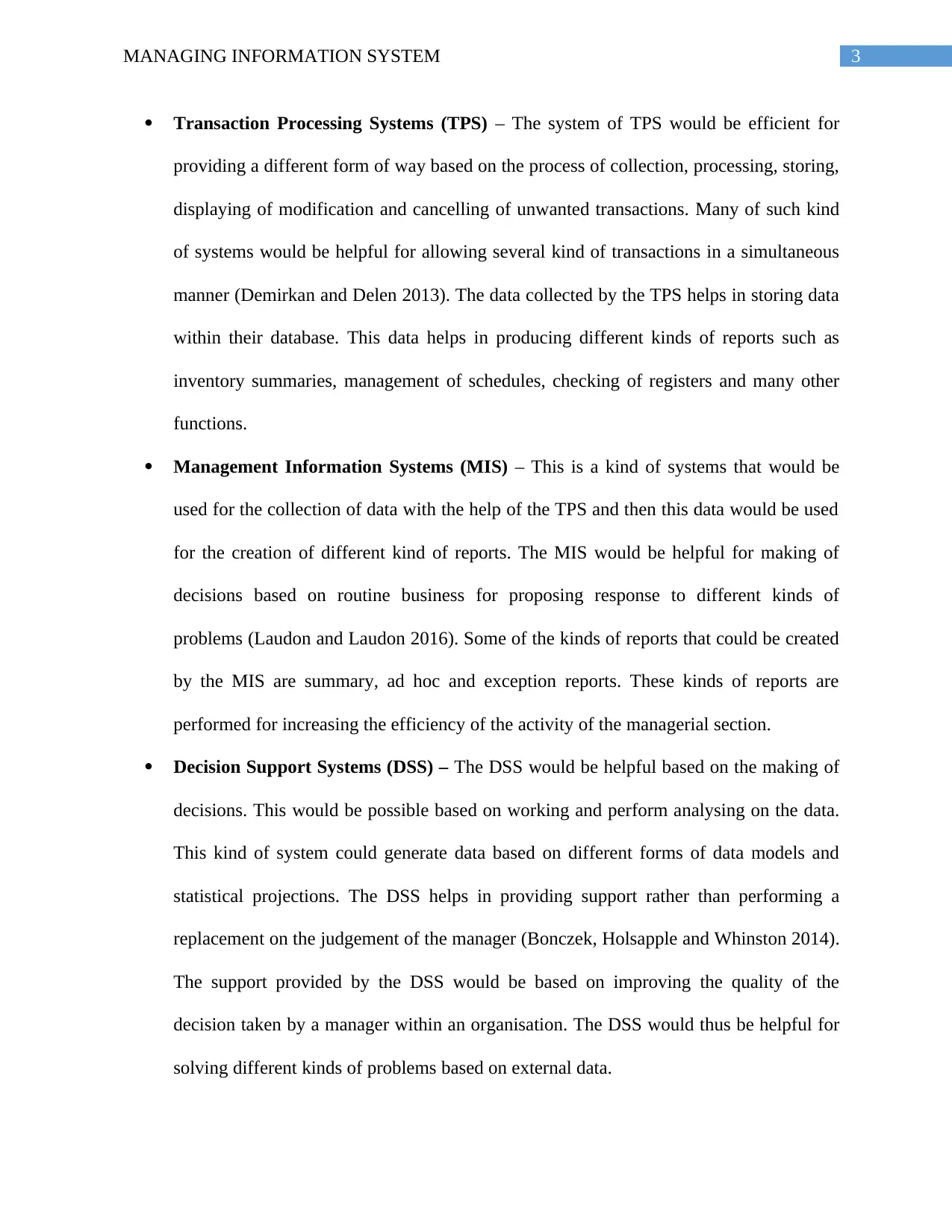
3MANAGING INFORMATION SYSTEM
Transaction Processing Systems (TPS) – The system of TPS would be efficient for
providing a different form of way based on the process of collection, processing, storing,
displaying of modification and cancelling of unwanted transactions. Many of such kind
of systems would be helpful for allowing several kind of transactions in a simultaneous
manner (Demirkan and Delen 2013). The data collected by the TPS helps in storing data
within their database. This data helps in producing different kinds of reports such as
inventory summaries, management of schedules, checking of registers and many other
functions.
Management Information Systems (MIS) – This is a kind of systems that would be
used for the collection of data with the help of the TPS and then this data would be used
for the creation of different kind of reports. The MIS would be helpful for making of
decisions based on routine business for proposing response to different kinds of
problems (Laudon and Laudon 2016). Some of the kinds of reports that could be created
by the MIS are summary, ad hoc and exception reports. These kinds of reports are
performed for increasing the efficiency of the activity of the managerial section.
Decision Support Systems (DSS) – The DSS would be helpful based on the making of
decisions. This would be possible based on working and perform analysing on the data.
This kind of system could generate data based on different forms of data models and
statistical projections. The DSS helps in providing support rather than performing a
replacement on the judgement of the manager (Bonczek, Holsapple and Whinston 2014).
The support provided by the DSS would be based on improving the quality of the
decision taken by a manager within an organisation. The DSS would thus be helpful for
solving different kinds of problems based on external data.
Transaction Processing Systems (TPS) – The system of TPS would be efficient for
providing a different form of way based on the process of collection, processing, storing,
displaying of modification and cancelling of unwanted transactions. Many of such kind
of systems would be helpful for allowing several kind of transactions in a simultaneous
manner (Demirkan and Delen 2013). The data collected by the TPS helps in storing data
within their database. This data helps in producing different kinds of reports such as
inventory summaries, management of schedules, checking of registers and many other
functions.
Management Information Systems (MIS) – This is a kind of systems that would be
used for the collection of data with the help of the TPS and then this data would be used
for the creation of different kind of reports. The MIS would be helpful for making of
decisions based on routine business for proposing response to different kinds of
problems (Laudon and Laudon 2016). Some of the kinds of reports that could be created
by the MIS are summary, ad hoc and exception reports. These kinds of reports are
performed for increasing the efficiency of the activity of the managerial section.
Decision Support Systems (DSS) – The DSS would be helpful based on the making of
decisions. This would be possible based on working and perform analysing on the data.
This kind of system could generate data based on different forms of data models and
statistical projections. The DSS helps in providing support rather than performing a
replacement on the judgement of the manager (Bonczek, Holsapple and Whinston 2014).
The support provided by the DSS would be based on improving the quality of the
decision taken by a manager within an organisation. The DSS would thus be helpful for
solving different kinds of problems based on external data.
Paraphrase This Document
Need a fresh take? Get an instant paraphrase of this document with our AI Paraphraser
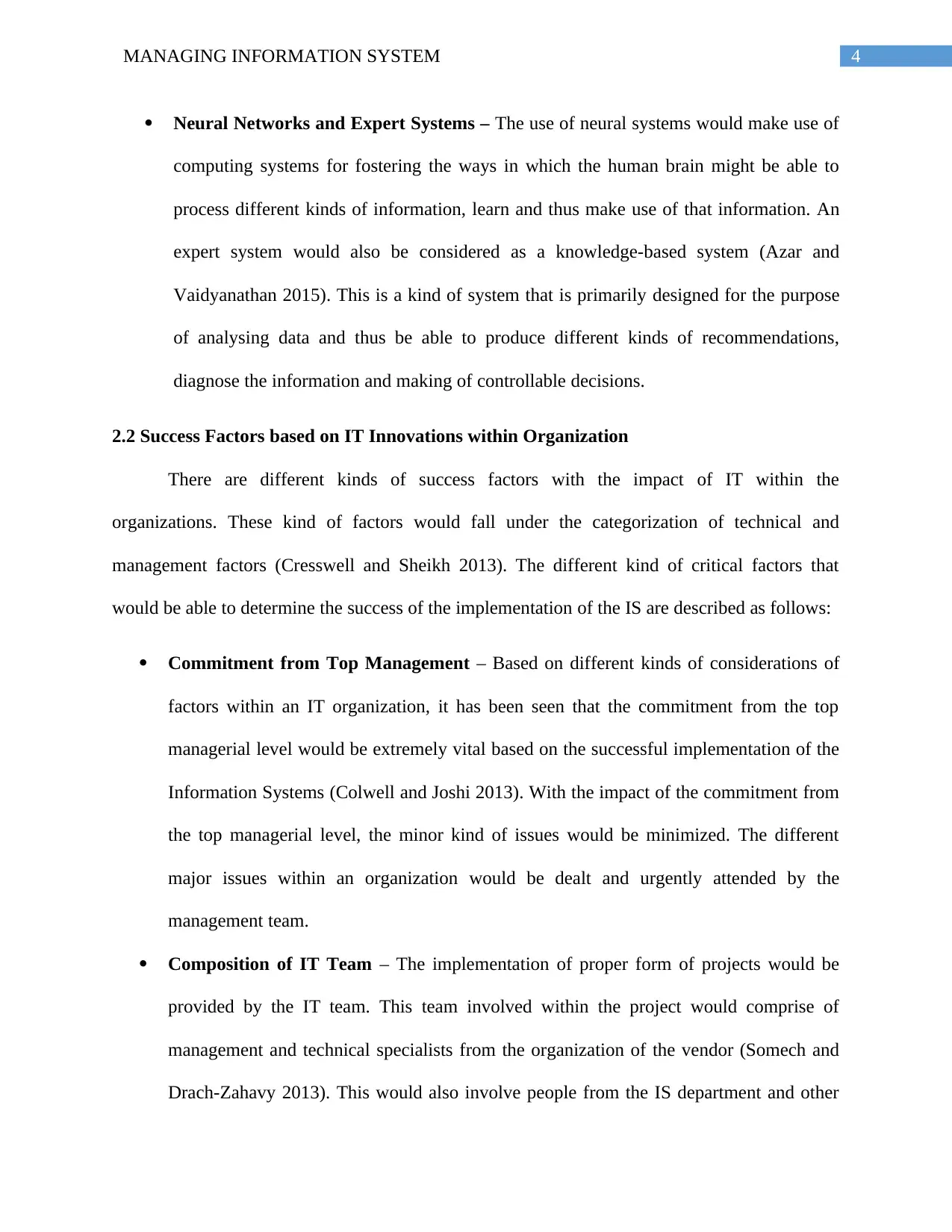
4MANAGING INFORMATION SYSTEM
Neural Networks and Expert Systems – The use of neural systems would make use of
computing systems for fostering the ways in which the human brain might be able to
process different kinds of information, learn and thus make use of that information. An
expert system would also be considered as a knowledge-based system (Azar and
Vaidyanathan 2015). This is a kind of system that is primarily designed for the purpose
of analysing data and thus be able to produce different kinds of recommendations,
diagnose the information and making of controllable decisions.
2.2 Success Factors based on IT Innovations within Organization
There are different kinds of success factors with the impact of IT within the
organizations. These kind of factors would fall under the categorization of technical and
management factors (Cresswell and Sheikh 2013). The different kind of critical factors that
would be able to determine the success of the implementation of the IS are described as follows:
Commitment from Top Management – Based on different kinds of considerations of
factors within an IT organization, it has been seen that the commitment from the top
managerial level would be extremely vital based on the successful implementation of the
Information Systems (Colwell and Joshi 2013). With the impact of the commitment from
the top managerial level, the minor kind of issues would be minimized. The different
major issues within an organization would be dealt and urgently attended by the
management team.
Composition of IT Team – The implementation of proper form of projects would be
provided by the IT team. This team involved within the project would comprise of
management and technical specialists from the organization of the vendor (Somech and
Drach-Zahavy 2013). This would also involve people from the IS department and other
Neural Networks and Expert Systems – The use of neural systems would make use of
computing systems for fostering the ways in which the human brain might be able to
process different kinds of information, learn and thus make use of that information. An
expert system would also be considered as a knowledge-based system (Azar and
Vaidyanathan 2015). This is a kind of system that is primarily designed for the purpose
of analysing data and thus be able to produce different kinds of recommendations,
diagnose the information and making of controllable decisions.
2.2 Success Factors based on IT Innovations within Organization
There are different kinds of success factors with the impact of IT within the
organizations. These kind of factors would fall under the categorization of technical and
management factors (Cresswell and Sheikh 2013). The different kind of critical factors that
would be able to determine the success of the implementation of the IS are described as follows:
Commitment from Top Management – Based on different kinds of considerations of
factors within an IT organization, it has been seen that the commitment from the top
managerial level would be extremely vital based on the successful implementation of the
Information Systems (Colwell and Joshi 2013). With the impact of the commitment from
the top managerial level, the minor kind of issues would be minimized. The different
major issues within an organization would be dealt and urgently attended by the
management team.
Composition of IT Team – The implementation of proper form of projects would be
provided by the IT team. This team involved within the project would comprise of
management and technical specialists from the organization of the vendor (Somech and
Drach-Zahavy 2013). This would also involve people from the IS department and other
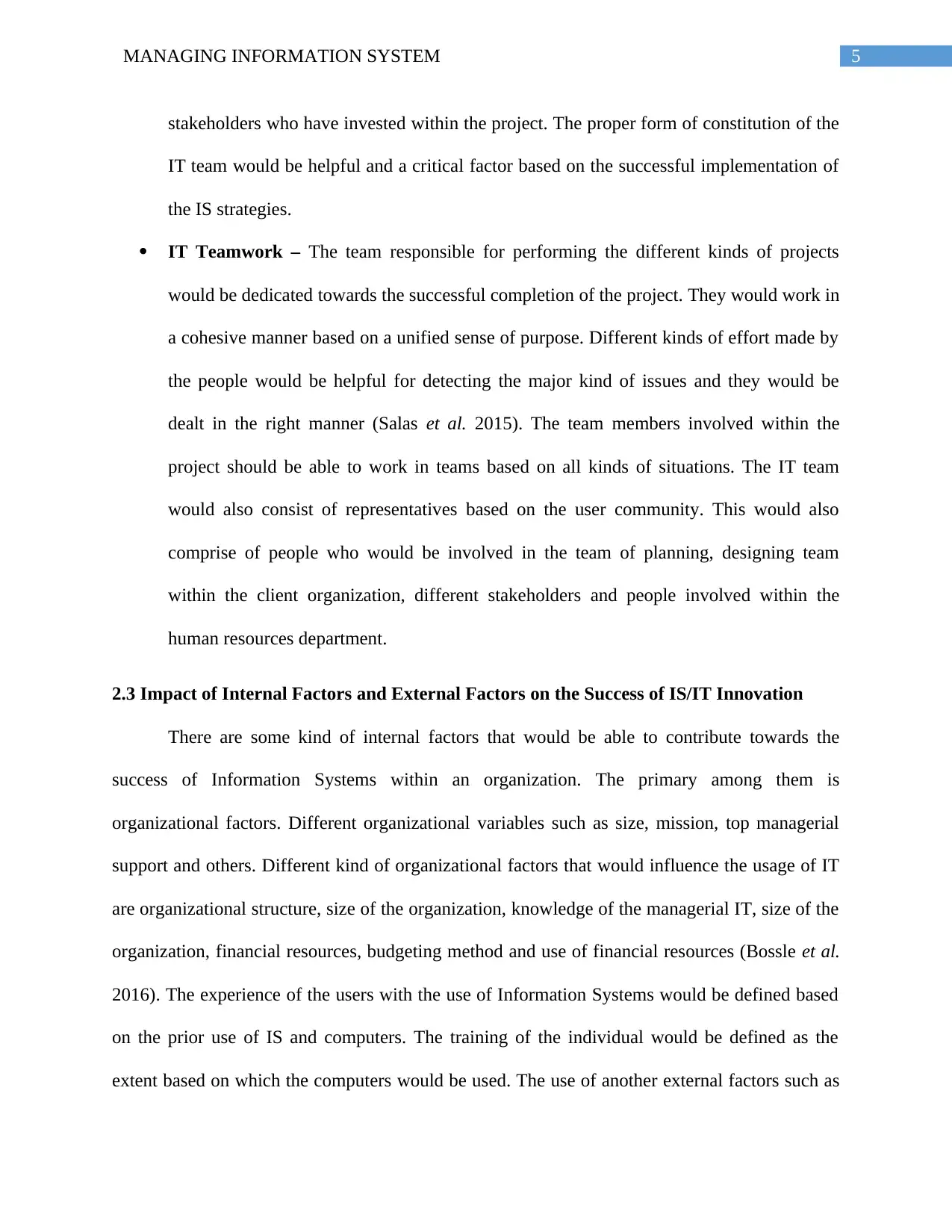
5MANAGING INFORMATION SYSTEM
stakeholders who have invested within the project. The proper form of constitution of the
IT team would be helpful and a critical factor based on the successful implementation of
the IS strategies.
IT Teamwork – The team responsible for performing the different kinds of projects
would be dedicated towards the successful completion of the project. They would work in
a cohesive manner based on a unified sense of purpose. Different kinds of effort made by
the people would be helpful for detecting the major kind of issues and they would be
dealt in the right manner (Salas et al. 2015). The team members involved within the
project should be able to work in teams based on all kinds of situations. The IT team
would also consist of representatives based on the user community. This would also
comprise of people who would be involved in the team of planning, designing team
within the client organization, different stakeholders and people involved within the
human resources department.
2.3 Impact of Internal Factors and External Factors on the Success of IS/IT Innovation
There are some kind of internal factors that would be able to contribute towards the
success of Information Systems within an organization. The primary among them is
organizational factors. Different organizational variables such as size, mission, top managerial
support and others. Different kind of organizational factors that would influence the usage of IT
are organizational structure, size of the organization, knowledge of the managerial IT, size of the
organization, financial resources, budgeting method and use of financial resources (Bossle et al.
2016). The experience of the users with the use of Information Systems would be defined based
on the prior use of IS and computers. The training of the individual would be defined as the
extent based on which the computers would be used. The use of another external factors such as
stakeholders who have invested within the project. The proper form of constitution of the
IT team would be helpful and a critical factor based on the successful implementation of
the IS strategies.
IT Teamwork – The team responsible for performing the different kinds of projects
would be dedicated towards the successful completion of the project. They would work in
a cohesive manner based on a unified sense of purpose. Different kinds of effort made by
the people would be helpful for detecting the major kind of issues and they would be
dealt in the right manner (Salas et al. 2015). The team members involved within the
project should be able to work in teams based on all kinds of situations. The IT team
would also consist of representatives based on the user community. This would also
comprise of people who would be involved in the team of planning, designing team
within the client organization, different stakeholders and people involved within the
human resources department.
2.3 Impact of Internal Factors and External Factors on the Success of IS/IT Innovation
There are some kind of internal factors that would be able to contribute towards the
success of Information Systems within an organization. The primary among them is
organizational factors. Different organizational variables such as size, mission, top managerial
support and others. Different kind of organizational factors that would influence the usage of IT
are organizational structure, size of the organization, knowledge of the managerial IT, size of the
organization, financial resources, budgeting method and use of financial resources (Bossle et al.
2016). The experience of the users with the use of Information Systems would be defined based
on the prior use of IS and computers. The training of the individual would be defined as the
extent based on which the computers would be used. The use of another external factors such as
⊘ This is a preview!⊘
Do you want full access?
Subscribe today to unlock all pages.

Trusted by 1+ million students worldwide
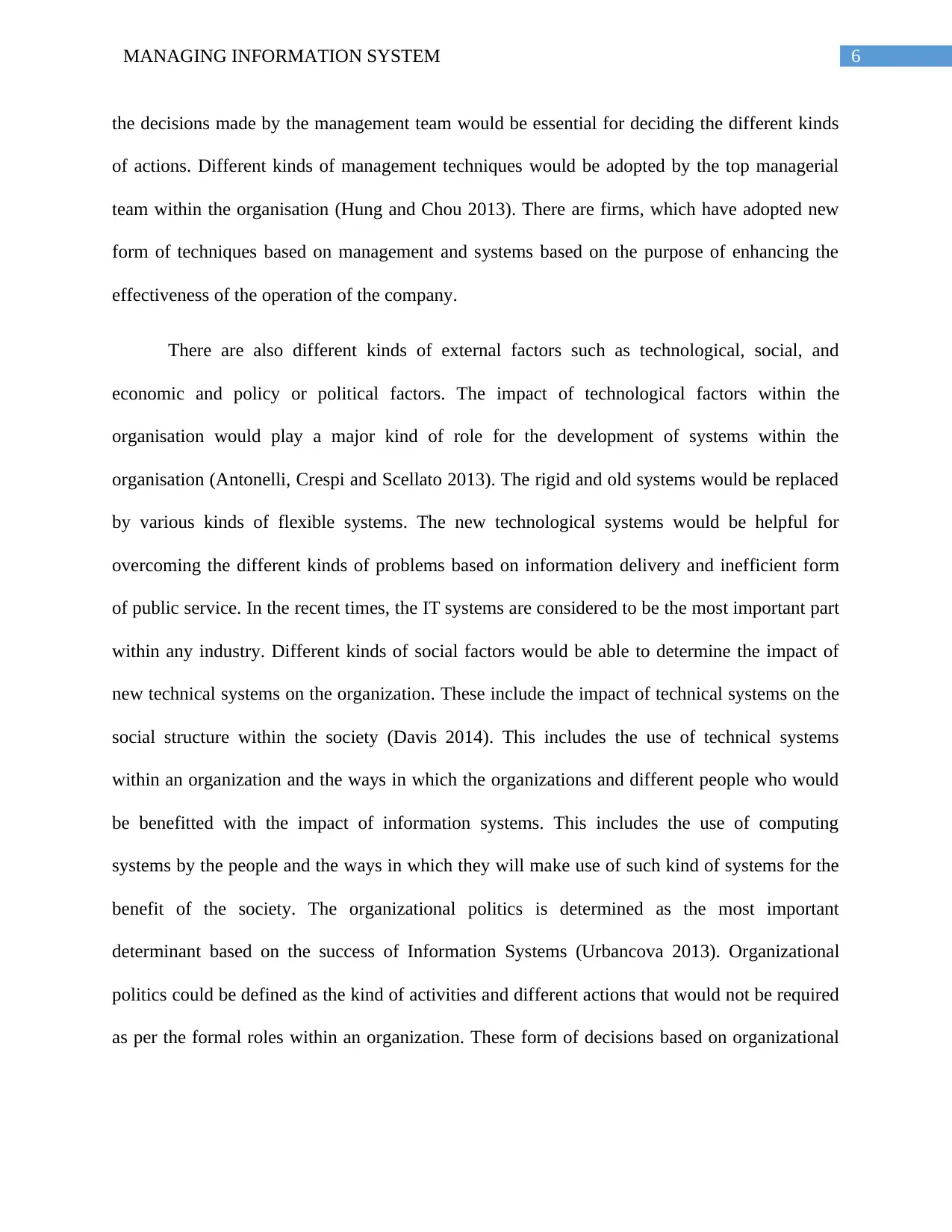
6MANAGING INFORMATION SYSTEM
the decisions made by the management team would be essential for deciding the different kinds
of actions. Different kinds of management techniques would be adopted by the top managerial
team within the organisation (Hung and Chou 2013). There are firms, which have adopted new
form of techniques based on management and systems based on the purpose of enhancing the
effectiveness of the operation of the company.
There are also different kinds of external factors such as technological, social, and
economic and policy or political factors. The impact of technological factors within the
organisation would play a major kind of role for the development of systems within the
organisation (Antonelli, Crespi and Scellato 2013). The rigid and old systems would be replaced
by various kinds of flexible systems. The new technological systems would be helpful for
overcoming the different kinds of problems based on information delivery and inefficient form
of public service. In the recent times, the IT systems are considered to be the most important part
within any industry. Different kinds of social factors would be able to determine the impact of
new technical systems on the organization. These include the impact of technical systems on the
social structure within the society (Davis 2014). This includes the use of technical systems
within an organization and the ways in which the organizations and different people who would
be benefitted with the impact of information systems. This includes the use of computing
systems by the people and the ways in which they will make use of such kind of systems for the
benefit of the society. The organizational politics is determined as the most important
determinant based on the success of Information Systems (Urbancova 2013). Organizational
politics could be defined as the kind of activities and different actions that would not be required
as per the formal roles within an organization. These form of decisions based on organizational
the decisions made by the management team would be essential for deciding the different kinds
of actions. Different kinds of management techniques would be adopted by the top managerial
team within the organisation (Hung and Chou 2013). There are firms, which have adopted new
form of techniques based on management and systems based on the purpose of enhancing the
effectiveness of the operation of the company.
There are also different kinds of external factors such as technological, social, and
economic and policy or political factors. The impact of technological factors within the
organisation would play a major kind of role for the development of systems within the
organisation (Antonelli, Crespi and Scellato 2013). The rigid and old systems would be replaced
by various kinds of flexible systems. The new technological systems would be helpful for
overcoming the different kinds of problems based on information delivery and inefficient form
of public service. In the recent times, the IT systems are considered to be the most important part
within any industry. Different kinds of social factors would be able to determine the impact of
new technical systems on the organization. These include the impact of technical systems on the
social structure within the society (Davis 2014). This includes the use of technical systems
within an organization and the ways in which the organizations and different people who would
be benefitted with the impact of information systems. This includes the use of computing
systems by the people and the ways in which they will make use of such kind of systems for the
benefit of the society. The organizational politics is determined as the most important
determinant based on the success of Information Systems (Urbancova 2013). Organizational
politics could be defined as the kind of activities and different actions that would not be required
as per the formal roles within an organization. These form of decisions based on organizational
Paraphrase This Document
Need a fresh take? Get an instant paraphrase of this document with our AI Paraphraser
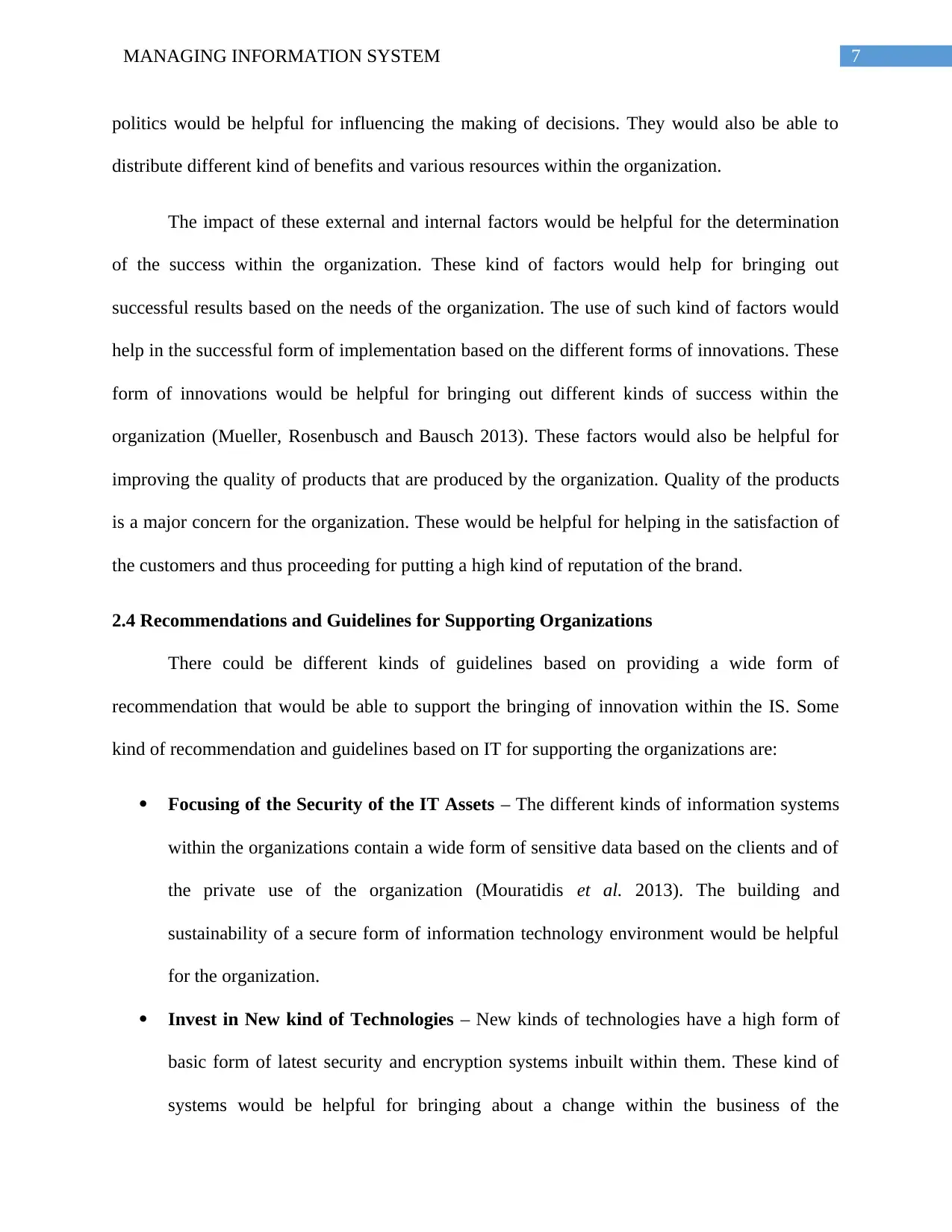
7MANAGING INFORMATION SYSTEM
politics would be helpful for influencing the making of decisions. They would also be able to
distribute different kind of benefits and various resources within the organization.
The impact of these external and internal factors would be helpful for the determination
of the success within the organization. These kind of factors would help for bringing out
successful results based on the needs of the organization. The use of such kind of factors would
help in the successful form of implementation based on the different forms of innovations. These
form of innovations would be helpful for bringing out different kinds of success within the
organization (Mueller, Rosenbusch and Bausch 2013). These factors would also be helpful for
improving the quality of products that are produced by the organization. Quality of the products
is a major concern for the organization. These would be helpful for helping in the satisfaction of
the customers and thus proceeding for putting a high kind of reputation of the brand.
2.4 Recommendations and Guidelines for Supporting Organizations
There could be different kinds of guidelines based on providing a wide form of
recommendation that would be able to support the bringing of innovation within the IS. Some
kind of recommendation and guidelines based on IT for supporting the organizations are:
Focusing of the Security of the IT Assets – The different kinds of information systems
within the organizations contain a wide form of sensitive data based on the clients and of
the private use of the organization (Mouratidis et al. 2013). The building and
sustainability of a secure form of information technology environment would be helpful
for the organization.
Invest in New kind of Technologies – New kinds of technologies have a high form of
basic form of latest security and encryption systems inbuilt within them. These kind of
systems would be helpful for bringing about a change within the business of the
politics would be helpful for influencing the making of decisions. They would also be able to
distribute different kind of benefits and various resources within the organization.
The impact of these external and internal factors would be helpful for the determination
of the success within the organization. These kind of factors would help for bringing out
successful results based on the needs of the organization. The use of such kind of factors would
help in the successful form of implementation based on the different forms of innovations. These
form of innovations would be helpful for bringing out different kinds of success within the
organization (Mueller, Rosenbusch and Bausch 2013). These factors would also be helpful for
improving the quality of products that are produced by the organization. Quality of the products
is a major concern for the organization. These would be helpful for helping in the satisfaction of
the customers and thus proceeding for putting a high kind of reputation of the brand.
2.4 Recommendations and Guidelines for Supporting Organizations
There could be different kinds of guidelines based on providing a wide form of
recommendation that would be able to support the bringing of innovation within the IS. Some
kind of recommendation and guidelines based on IT for supporting the organizations are:
Focusing of the Security of the IT Assets – The different kinds of information systems
within the organizations contain a wide form of sensitive data based on the clients and of
the private use of the organization (Mouratidis et al. 2013). The building and
sustainability of a secure form of information technology environment would be helpful
for the organization.
Invest in New kind of Technologies – New kinds of technologies have a high form of
basic form of latest security and encryption systems inbuilt within them. These kind of
systems would be helpful for bringing about a change within the business of the
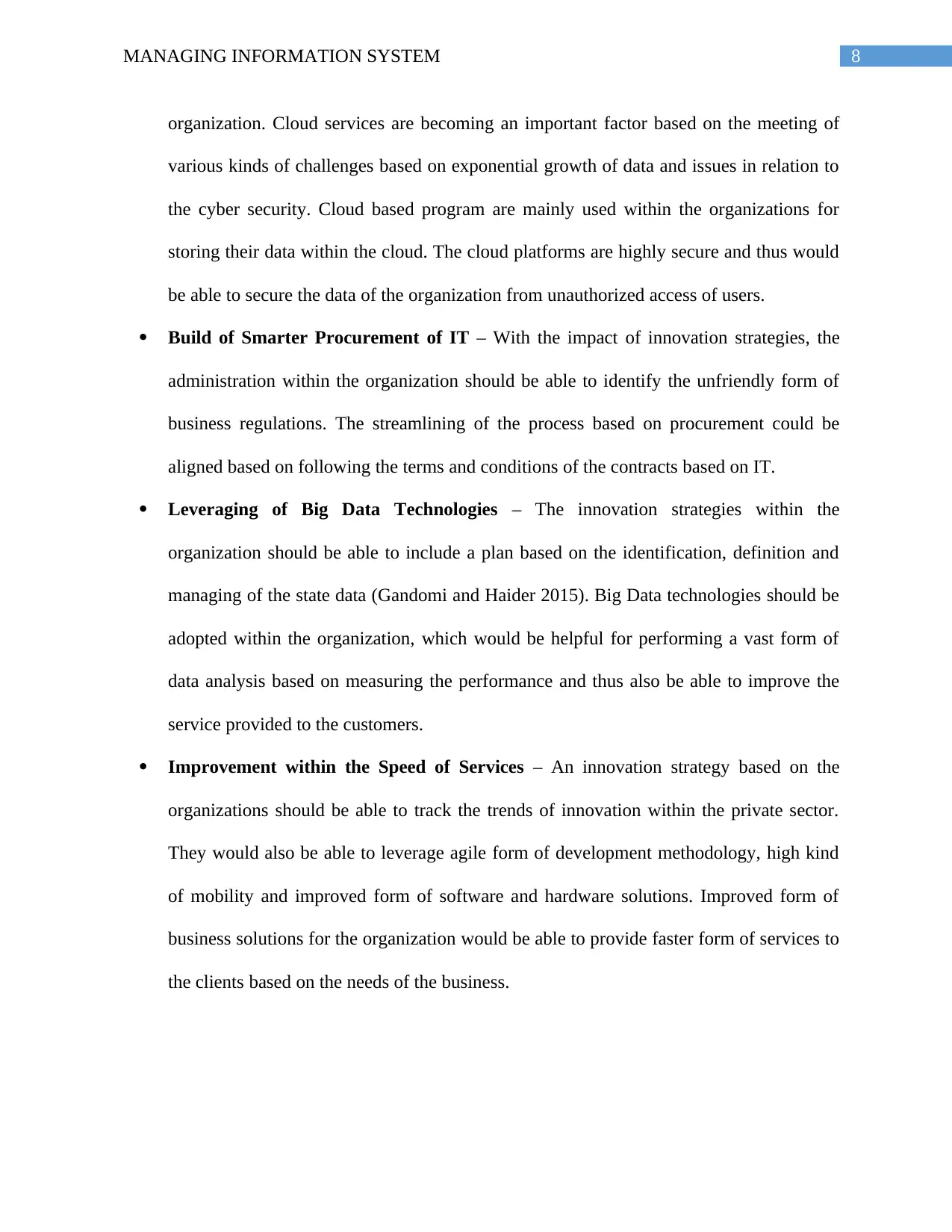
8MANAGING INFORMATION SYSTEM
organization. Cloud services are becoming an important factor based on the meeting of
various kinds of challenges based on exponential growth of data and issues in relation to
the cyber security. Cloud based program are mainly used within the organizations for
storing their data within the cloud. The cloud platforms are highly secure and thus would
be able to secure the data of the organization from unauthorized access of users.
Build of Smarter Procurement of IT – With the impact of innovation strategies, the
administration within the organization should be able to identify the unfriendly form of
business regulations. The streamlining of the process based on procurement could be
aligned based on following the terms and conditions of the contracts based on IT.
Leveraging of Big Data Technologies – The innovation strategies within the
organization should be able to include a plan based on the identification, definition and
managing of the state data (Gandomi and Haider 2015). Big Data technologies should be
adopted within the organization, which would be helpful for performing a vast form of
data analysis based on measuring the performance and thus also be able to improve the
service provided to the customers.
Improvement within the Speed of Services – An innovation strategy based on the
organizations should be able to track the trends of innovation within the private sector.
They would also be able to leverage agile form of development methodology, high kind
of mobility and improved form of software and hardware solutions. Improved form of
business solutions for the organization would be able to provide faster form of services to
the clients based on the needs of the business.
organization. Cloud services are becoming an important factor based on the meeting of
various kinds of challenges based on exponential growth of data and issues in relation to
the cyber security. Cloud based program are mainly used within the organizations for
storing their data within the cloud. The cloud platforms are highly secure and thus would
be able to secure the data of the organization from unauthorized access of users.
Build of Smarter Procurement of IT – With the impact of innovation strategies, the
administration within the organization should be able to identify the unfriendly form of
business regulations. The streamlining of the process based on procurement could be
aligned based on following the terms and conditions of the contracts based on IT.
Leveraging of Big Data Technologies – The innovation strategies within the
organization should be able to include a plan based on the identification, definition and
managing of the state data (Gandomi and Haider 2015). Big Data technologies should be
adopted within the organization, which would be helpful for performing a vast form of
data analysis based on measuring the performance and thus also be able to improve the
service provided to the customers.
Improvement within the Speed of Services – An innovation strategy based on the
organizations should be able to track the trends of innovation within the private sector.
They would also be able to leverage agile form of development methodology, high kind
of mobility and improved form of software and hardware solutions. Improved form of
business solutions for the organization would be able to provide faster form of services to
the clients based on the needs of the business.
⊘ This is a preview!⊘
Do you want full access?
Subscribe today to unlock all pages.

Trusted by 1+ million students worldwide
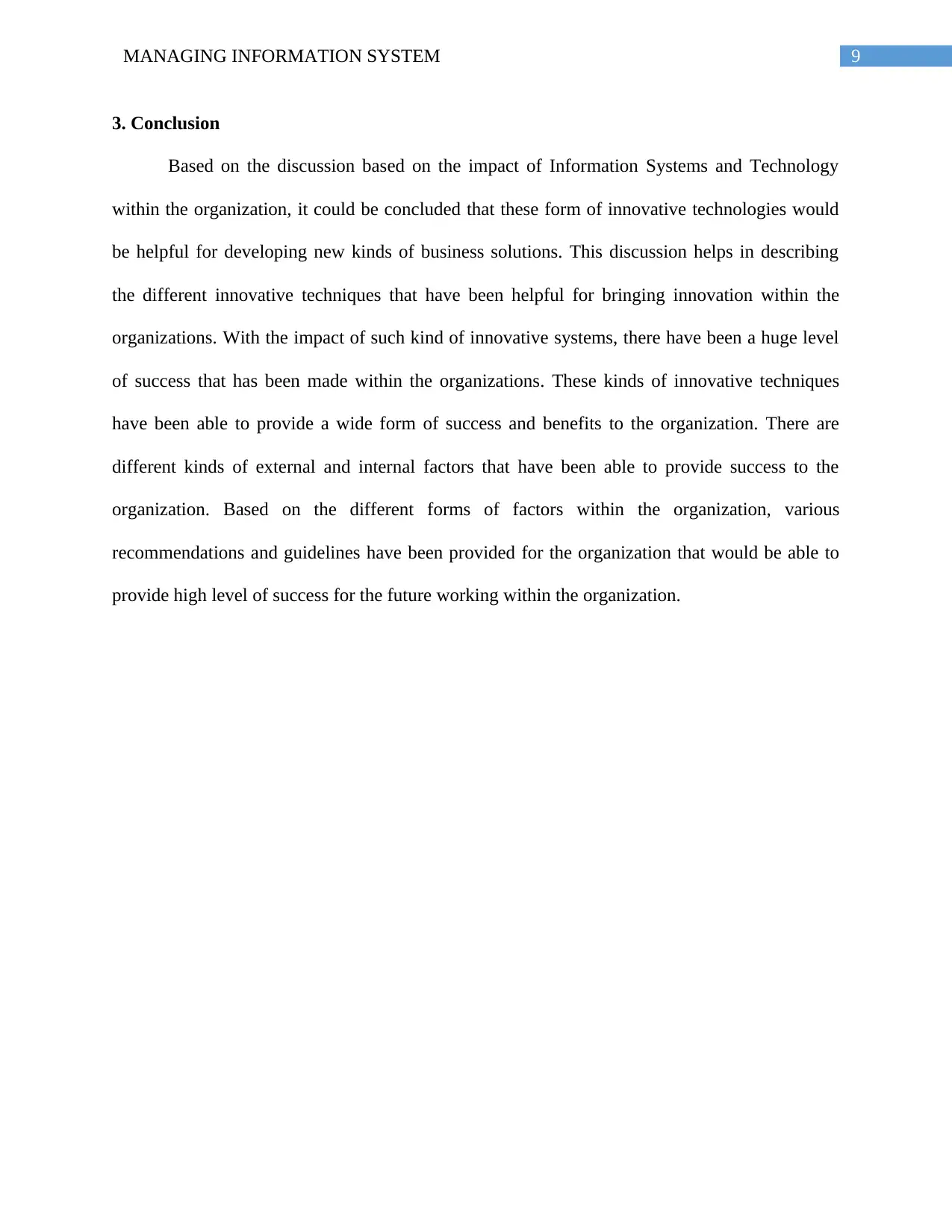
9MANAGING INFORMATION SYSTEM
3. Conclusion
Based on the discussion based on the impact of Information Systems and Technology
within the organization, it could be concluded that these form of innovative technologies would
be helpful for developing new kinds of business solutions. This discussion helps in describing
the different innovative techniques that have been helpful for bringing innovation within the
organizations. With the impact of such kind of innovative systems, there have been a huge level
of success that has been made within the organizations. These kinds of innovative techniques
have been able to provide a wide form of success and benefits to the organization. There are
different kinds of external and internal factors that have been able to provide success to the
organization. Based on the different forms of factors within the organization, various
recommendations and guidelines have been provided for the organization that would be able to
provide high level of success for the future working within the organization.
3. Conclusion
Based on the discussion based on the impact of Information Systems and Technology
within the organization, it could be concluded that these form of innovative technologies would
be helpful for developing new kinds of business solutions. This discussion helps in describing
the different innovative techniques that have been helpful for bringing innovation within the
organizations. With the impact of such kind of innovative systems, there have been a huge level
of success that has been made within the organizations. These kinds of innovative techniques
have been able to provide a wide form of success and benefits to the organization. There are
different kinds of external and internal factors that have been able to provide success to the
organization. Based on the different forms of factors within the organization, various
recommendations and guidelines have been provided for the organization that would be able to
provide high level of success for the future working within the organization.
Paraphrase This Document
Need a fresh take? Get an instant paraphrase of this document with our AI Paraphraser
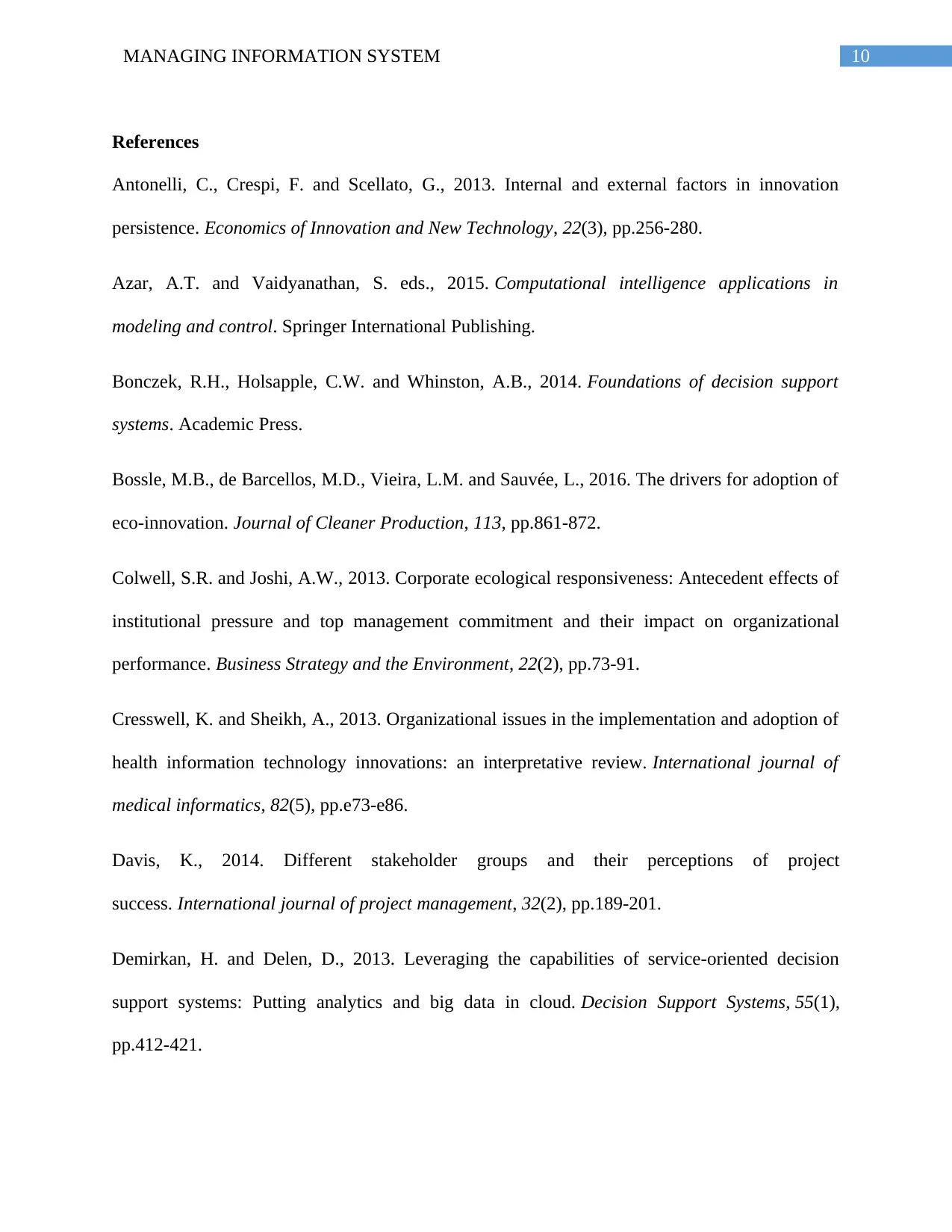
10MANAGING INFORMATION SYSTEM
References
Antonelli, C., Crespi, F. and Scellato, G., 2013. Internal and external factors in innovation
persistence. Economics of Innovation and New Technology, 22(3), pp.256-280.
Azar, A.T. and Vaidyanathan, S. eds., 2015. Computational intelligence applications in
modeling and control. Springer International Publishing.
Bonczek, R.H., Holsapple, C.W. and Whinston, A.B., 2014. Foundations of decision support
systems. Academic Press.
Bossle, M.B., de Barcellos, M.D., Vieira, L.M. and Sauvée, L., 2016. The drivers for adoption of
eco-innovation. Journal of Cleaner Production, 113, pp.861-872.
Colwell, S.R. and Joshi, A.W., 2013. Corporate ecological responsiveness: Antecedent effects of
institutional pressure and top management commitment and their impact on organizational
performance. Business Strategy and the Environment, 22(2), pp.73-91.
Cresswell, K. and Sheikh, A., 2013. Organizational issues in the implementation and adoption of
health information technology innovations: an interpretative review. International journal of
medical informatics, 82(5), pp.e73-e86.
Davis, K., 2014. Different stakeholder groups and their perceptions of project
success. International journal of project management, 32(2), pp.189-201.
Demirkan, H. and Delen, D., 2013. Leveraging the capabilities of service-oriented decision
support systems: Putting analytics and big data in cloud. Decision Support Systems, 55(1),
pp.412-421.
References
Antonelli, C., Crespi, F. and Scellato, G., 2013. Internal and external factors in innovation
persistence. Economics of Innovation and New Technology, 22(3), pp.256-280.
Azar, A.T. and Vaidyanathan, S. eds., 2015. Computational intelligence applications in
modeling and control. Springer International Publishing.
Bonczek, R.H., Holsapple, C.W. and Whinston, A.B., 2014. Foundations of decision support
systems. Academic Press.
Bossle, M.B., de Barcellos, M.D., Vieira, L.M. and Sauvée, L., 2016. The drivers for adoption of
eco-innovation. Journal of Cleaner Production, 113, pp.861-872.
Colwell, S.R. and Joshi, A.W., 2013. Corporate ecological responsiveness: Antecedent effects of
institutional pressure and top management commitment and their impact on organizational
performance. Business Strategy and the Environment, 22(2), pp.73-91.
Cresswell, K. and Sheikh, A., 2013. Organizational issues in the implementation and adoption of
health information technology innovations: an interpretative review. International journal of
medical informatics, 82(5), pp.e73-e86.
Davis, K., 2014. Different stakeholder groups and their perceptions of project
success. International journal of project management, 32(2), pp.189-201.
Demirkan, H. and Delen, D., 2013. Leveraging the capabilities of service-oriented decision
support systems: Putting analytics and big data in cloud. Decision Support Systems, 55(1),
pp.412-421.
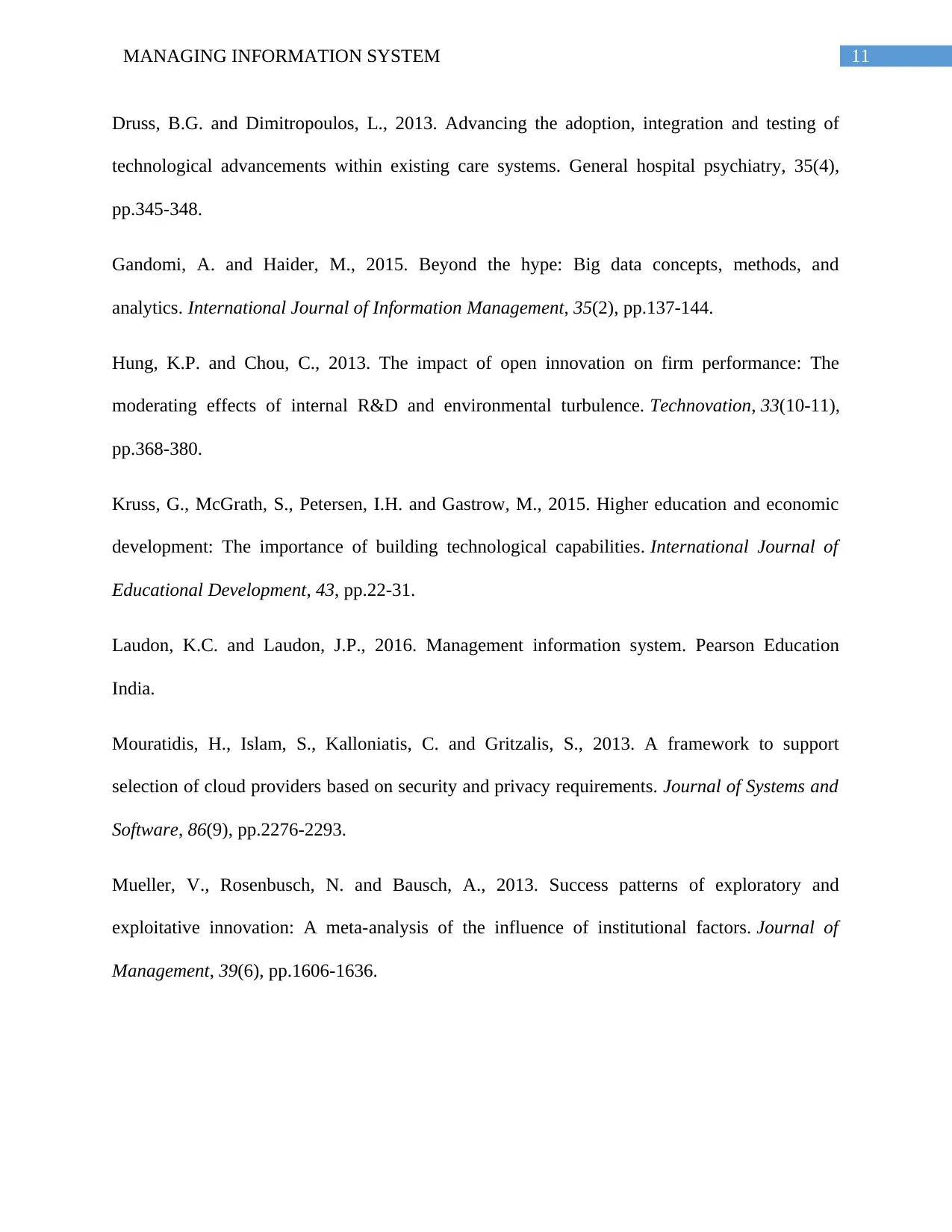
11MANAGING INFORMATION SYSTEM
Druss, B.G. and Dimitropoulos, L., 2013. Advancing the adoption, integration and testing of
technological advancements within existing care systems. General hospital psychiatry, 35(4),
pp.345-348.
Gandomi, A. and Haider, M., 2015. Beyond the hype: Big data concepts, methods, and
analytics. International Journal of Information Management, 35(2), pp.137-144.
Hung, K.P. and Chou, C., 2013. The impact of open innovation on firm performance: The
moderating effects of internal R&D and environmental turbulence. Technovation, 33(10-11),
pp.368-380.
Kruss, G., McGrath, S., Petersen, I.H. and Gastrow, M., 2015. Higher education and economic
development: The importance of building technological capabilities. International Journal of
Educational Development, 43, pp.22-31.
Laudon, K.C. and Laudon, J.P., 2016. Management information system. Pearson Education
India.
Mouratidis, H., Islam, S., Kalloniatis, C. and Gritzalis, S., 2013. A framework to support
selection of cloud providers based on security and privacy requirements. Journal of Systems and
Software, 86(9), pp.2276-2293.
Mueller, V., Rosenbusch, N. and Bausch, A., 2013. Success patterns of exploratory and
exploitative innovation: A meta-analysis of the influence of institutional factors. Journal of
Management, 39(6), pp.1606-1636.
Druss, B.G. and Dimitropoulos, L., 2013. Advancing the adoption, integration and testing of
technological advancements within existing care systems. General hospital psychiatry, 35(4),
pp.345-348.
Gandomi, A. and Haider, M., 2015. Beyond the hype: Big data concepts, methods, and
analytics. International Journal of Information Management, 35(2), pp.137-144.
Hung, K.P. and Chou, C., 2013. The impact of open innovation on firm performance: The
moderating effects of internal R&D and environmental turbulence. Technovation, 33(10-11),
pp.368-380.
Kruss, G., McGrath, S., Petersen, I.H. and Gastrow, M., 2015. Higher education and economic
development: The importance of building technological capabilities. International Journal of
Educational Development, 43, pp.22-31.
Laudon, K.C. and Laudon, J.P., 2016. Management information system. Pearson Education
India.
Mouratidis, H., Islam, S., Kalloniatis, C. and Gritzalis, S., 2013. A framework to support
selection of cloud providers based on security and privacy requirements. Journal of Systems and
Software, 86(9), pp.2276-2293.
Mueller, V., Rosenbusch, N. and Bausch, A., 2013. Success patterns of exploratory and
exploitative innovation: A meta-analysis of the influence of institutional factors. Journal of
Management, 39(6), pp.1606-1636.
⊘ This is a preview!⊘
Do you want full access?
Subscribe today to unlock all pages.

Trusted by 1+ million students worldwide
1 out of 13
Related Documents
Your All-in-One AI-Powered Toolkit for Academic Success.
+13062052269
info@desklib.com
Available 24*7 on WhatsApp / Email
![[object Object]](/_next/static/media/star-bottom.7253800d.svg)
Unlock your academic potential
Copyright © 2020–2025 A2Z Services. All Rights Reserved. Developed and managed by ZUCOL.





